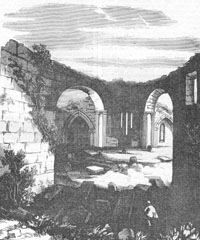Corcomroe Abbey, County Clare
From The Illustrated Dublin Journal, Volume 1, Number 31, April 5, 1862
THE Abbey of Corcomroe is situated in a lonely winding vale in the barony of Burren, and county of Clare. It was anciently called Corcamruadh, from the Irish Cor, a district, Cam, a quarrel, and Ruaidh, red, and was also denominated the abbey "De Viridi Saxo," or "of the Green Rock," from the amazing fertility of the mountainous and stony land around it.
Even the interior of the abbey at this day presents a surface of nothing
but rugged stones. The ruin of Corcomroe Abbey is one of great
splendour. In the engraving the spectator is supposed to stand near one
of the angles at the western end of the nave, immediately under the
square steeple or belfry. Before him is the choir, exhibiting a groined
arch, inferior to none--that of Holycross, in the county of Tipperary,
excepted--and the north and south transepts, opening to the right and
left by large plain circular arches, through which are visible two
small chapels, situate on either side of the choir. This fabric stood
in the centre of a square plot of land containing about six acres, and
which was enclosed with a wall ten feet high. The entrance was by an
arched gateway and gatehouse opposite to the western end of the abbey.
In the engraving the spectator is supposed to stand near one
of the angles at the western end of the nave, immediately under the
square steeple or belfry. Before him is the choir, exhibiting a groined
arch, inferior to none--that of Holycross, in the county of Tipperary,
excepted--and the north and south transepts, opening to the right and
left by large plain circular arches, through which are visible two
small chapels, situate on either side of the choir. This fabric stood
in the centre of a square plot of land containing about six acres, and
which was enclosed with a wall ten feet high. The entrance was by an
arched gateway and gatehouse opposite to the western end of the abbey.
Corcomroe was, in the year 1088, thrice plundered by Roderic O'Connor and Dermot O'Brien. According to the red book of Kilkenny, in 1194, Donald, King of Limerick, founded a sumptuous monastery here for Cistercian monks, and dedicated it to the Virgin Mary, while other authorities assert that his son, Donogh Carbrac, was the founder, in the year 1200. This abbey was an adjunct to that of Suire. It was afterwards made subject to the celebrated abbey of Furnes, in Lancashire. The cell of Kilsonna, otherwise Kilshanny, was some time after annexed to this house.
In 1267, Donogh O'Brien, King of Thomond, was killed in the battle of Sindaine, in this barony, and was solemnly interred in the abbey, where was erected to his memory a grand monument, the remains of which are to be seen at the present day. It is placed in a niche on the north side of the choir.
A great battle was fought near this abbey in 1317, in which many of the principal O'Briens fell. Amongst the slain were two sons of Brien Ruadh, (or the Red,) King of Thomond, viz , Teigh and Murtogh Garbh, or the boisterous, from the latter of whom it is probable the neighbouring village of Murtoghclogh takes its name. The ground where this battle took place lies along the bottom of the hill betwen the village of Murtogclogh and the abbey, which is now called the Hill of the Gallows.
John, abbot of Corcomroe, was, in 1118, made Bishop of Kilmacduach; and Archdall reports that the abbey, with eleven quarters of land in Corcomroe and Gleammangh were ultimately granted to Richard Harding. Notwithstanding this grant, it appears that this religious establishment was not forsaken by the Cistercian monks as late at least as 1628, and that is was subject to the Cistercian Lord Abbot of Holycross, whose predecessors were mitred abbotts and peers.
